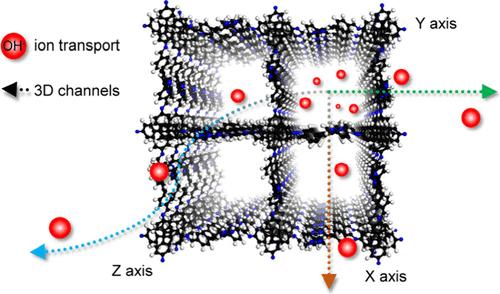3D Covalent Organic Framework Membrane with Interactive Ion Nanochannels for Hydroxide Conduction
IF 14.4
1区 化学
Q1 CHEMISTRY, MULTIDISCIPLINARY
引用次数: 0
Abstract
Crystalline porous materials, known for their ordered structures, hold promise for efficient hydroxide conductivity in alkaline fuel cells with limited ionic densities. However, the rigid cross-linking of porous materials precludes their processing into membranes, while composite membranes diminish materials’ conductivity advantage due to the interrupted phases. Here, we report a self-standing three-dimensional covalent organic framework (3D COF) membrane with efficient OH-transport through its interconnected 3D ionic nanochannels. The large-area, homogeneously connected COF membrane, with an 8 cm diameter and 20 μm thickness, was prepared using an interface polymerization strategy assisted by sacrificial templates of a polyacrylonitrile membrane. At the microscopic level, the introduction of imidazolium salt-building units resulted in a noninterpenetrated structure of 3D COF, creating a 3D interactive continuous hydrophilic channel for OH–-conduction. The 3D COF membrane demonstrated high conductivity (169 mS/cm at 80 °C, 100% humidity) and achieved a peak power density of 160 mW/cm2 in H2/O2 single-cell tests. This COF interface polymerization strategy brings new possibilities to address the challenges of porous material membrane formation and is expected to advance their practical applications in the field of ion transport.

具有相互作用离子纳米通道的氢氧根传导的三维共价有机框架膜
晶体多孔材料以其有序结构而著称,有望在离子密度有限的碱性燃料电池中实现高效氢氧化物传导。然而,多孔材料的刚性交联使其无法加工成膜,而复合膜则由于相的中断而削弱了材料的导电优势。在此,我们报告了一种自立式三维共价有机框架(3D COF)膜,通过其相互连接的三维离子纳米通道实现了高效的 OH 传输。这种大面积、均匀连接的 COF 膜直径为 8 厘米,厚度为 20 微米,是在聚丙烯腈膜牺牲模板的辅助下采用界面聚合策略制备的。在微观层面上,咪唑盐构建单元的引入形成了三维 COF 的非互穿结构,为羟基传导创造了一个三维交互式连续亲水通道。三维 COF 膜具有很高的导电性(在 80 °C、100% 湿度条件下为 169 mS/cm),并在 H2/O2 单细胞测试中达到了 160 mW/cm2 的峰值功率密度。这种 COF 界面聚合策略为应对多孔材料膜形成的挑战带来了新的可能性,有望推动其在离子传输领域的实际应用。
本文章由计算机程序翻译,如有差异,请以英文原文为准。
求助全文
约1分钟内获得全文
求助全文
来源期刊
CiteScore
24.40
自引率
6.00%
发文量
2398
审稿时长
1.6 months
期刊介绍:
The flagship journal of the American Chemical Society, known as the Journal of the American Chemical Society (JACS), has been a prestigious publication since its establishment in 1879. It holds a preeminent position in the field of chemistry and related interdisciplinary sciences. JACS is committed to disseminating cutting-edge research papers, covering a wide range of topics, and encompasses approximately 19,000 pages of Articles, Communications, and Perspectives annually. With a weekly publication frequency, JACS plays a vital role in advancing the field of chemistry by providing essential research.

 求助内容:
求助内容: 应助结果提醒方式:
应助结果提醒方式:


